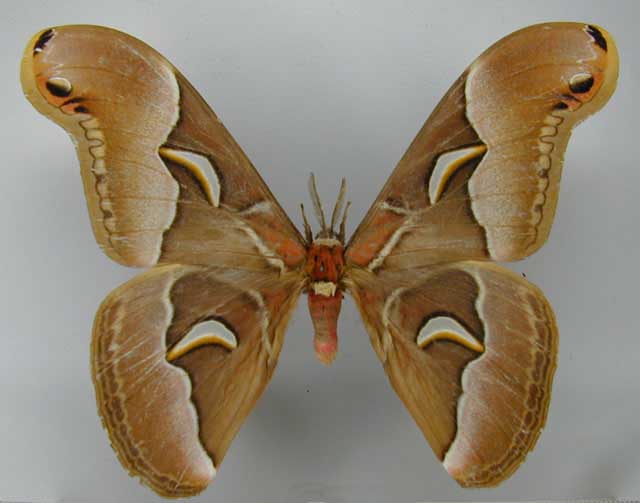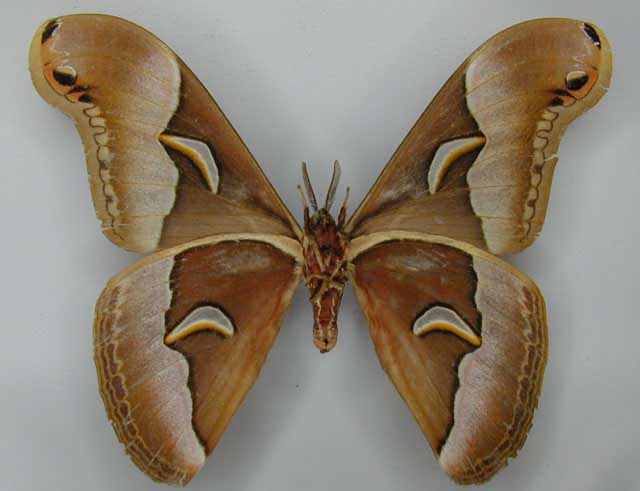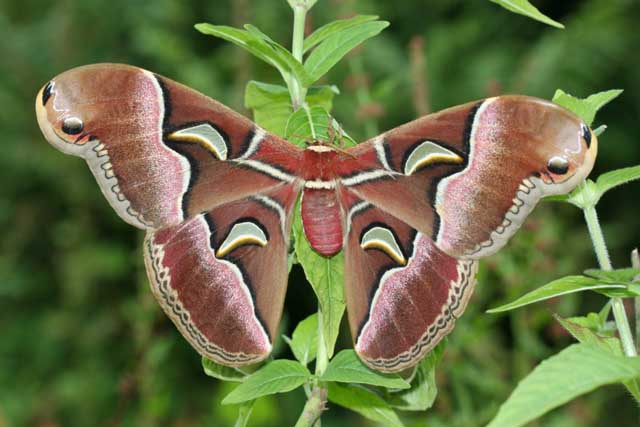Samia watsoni
|
|
Updated as per Entomofauna Monograph 1: 56-63, September 2007, Samia notes and New Taxa from Indonesia, courtesy of Ronald Brechlin, February 2008
|
Archaeosamia watsoni
(Oberthur, 1914)
(Desgodinsia Watsoni)

| TAXONOMY:
Superfamily: Bombycoidea, Latreille, 1802
Family: Saturniidae, Boisduval, [1837] 1834
Subfamily: Saturniinae, Boisduval, [1837] 1834
Tribe: Attacini, Blanchard, 1840
Genus: Samia, Hubner, 1819
| |
MIDI MUSIC
"Asian Spring Blossoms"
ON.OFF
<bgsound src="AsianSpringBlossoms.mid" LOOP=FOREVER>
|
DISTRIBUTION:
Archaeosamia watsoni
(forewing length: males: 55-72mm; females: 74-78mm in China;
males: 78-82 in Taiwan) flies
throughout much of China: Shaanxi; Sichuan;
Guangdong; Jiangxi: Wuyi Shan, Xipaihe; Fujian; (probably Ghizhou, Guangxi, Hunan, etc.);
Taiwan;
and
possibly ?? in northern Vietnam at elevations from
1300-2400m. The above moth was
sent to me as Samia watsoni formosana.
Peigler and Naumann
have equated Samia watsoni formosana with Samia watsoni
and indicate it is the only Samia with a true hyaline area and
a secondary eyespot near the tip of the forewing apex with additional
spots below the main eyespot.

Archaeosamia watsoni male, courtesy of
Ronald Brechlin.

Archaeosamia watsoni male (verso), courtesy of
Ronald Brechlin.
Its very large size (forewing length: males: 70-80mm; females: 66-78mm),
burgundy to reddish brown ground colour, extremely "wavy" pm lines
with the outermost line very diffuse, and the previously listed
traits suggest a small Archaeoattacus or intermediary genus.
The moth is named to honour J. Henry Watson, a Saturniidae
enthusiast from England.
Dr. Ronald Brechlin, 2007, has assigned this moth
to a new genus, Archaeosamia.
FLIGHT TIMES AND PREFERRED FOOD PLANTS:
The species is
probably bivoltine in more southerly latitides and univoltine
in northernmost portions of its range.
Moths are recorded for April-May-June-July-August-September
Manihot esculenta ("Sweet potato tree") is a possible host.
Liquidambar formosana (Chinese sweetgum) has been utilized
with very limited success.
ECLOSION, SCENTING AND MATING:
The female begins
scenting after dark by projecting a scent gland from the posterior
tip of her abdomen. Males fly into the breeze and hone in on the
pheromone plume via their highly developed and sensitive antennae.

Archaeosamia watsoni female, Meigu, Sichuan, China, courtesy of Victor Sinyaev.
EGGS, LARVAE, COCOONS AND PUPAE:
Eggs are probably
deposited on host foliage with incubation requiring eight to ten
days, longer in cooler conditions.
Larval Food Plants
It is hoped that this alphabetical listing followed by the common
name of the foodplant will prove useful. The list is not exhaustive.
Experimenting with closely related foodplants is worthwhile.
Use your browser "Back" button to return to the previous page.
Return to Main Index
Return to Samia genus



